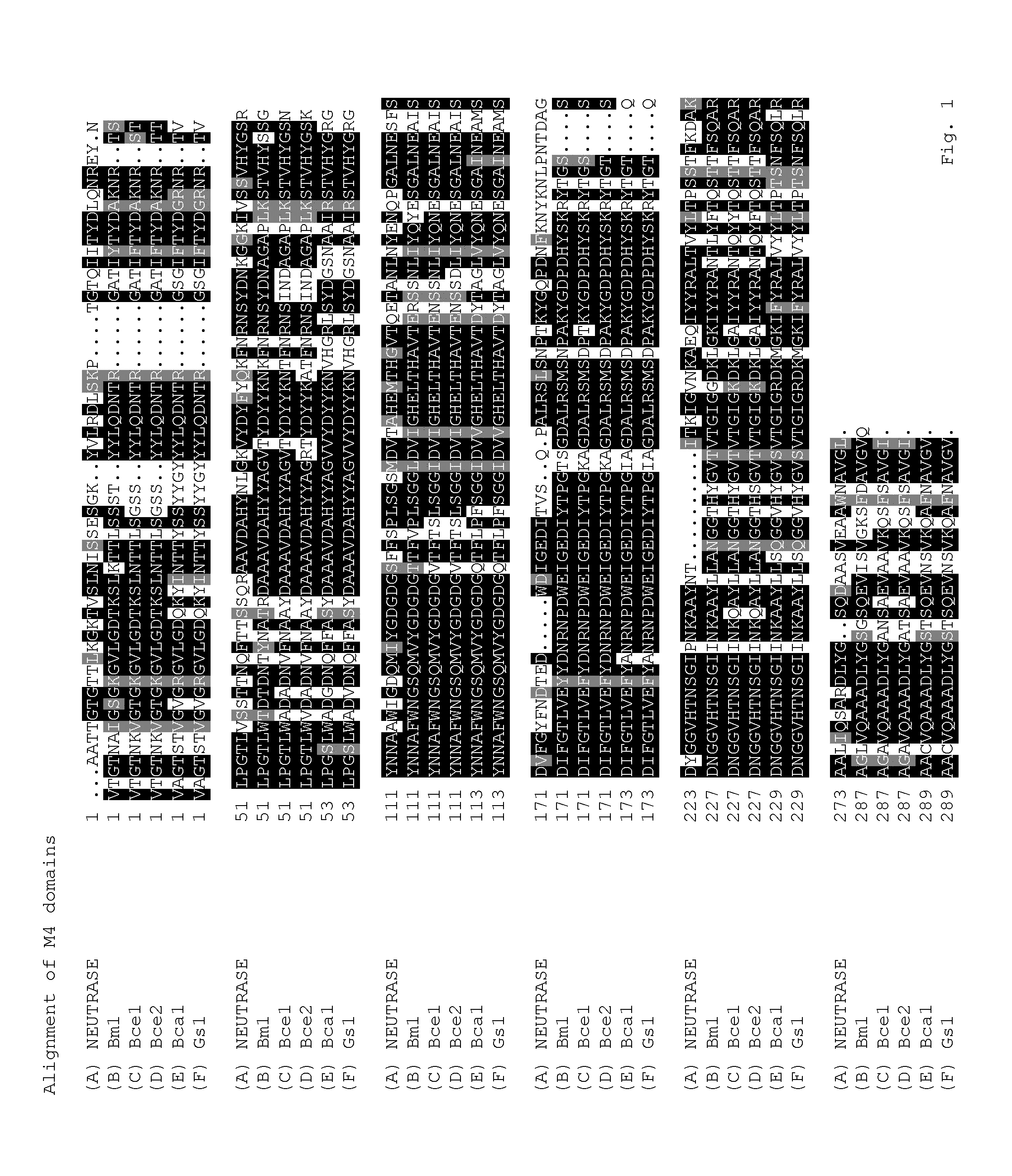Detergent Compositions Comprising Metalloproteases
a technology of detergent composition and metalloprotease, which is applied in the direction of detergent compounding agent, peptidase, enzymology, etc., can solve the problems of limited use of metalloprotease in the detergent industry, and inability to meet the needs of washing and cleaning
- Summary
- Abstract
- Description
- Claims
- Application Information
AI Technical Summary
Benefits of technology
Problems solved by technology
Method used
Image
Examples
example 1
Purification of Gs1 from Geobacillus stearothermophilus and Bca1 from Bacillus caldolyticus
[0224]The Gs1 and Bca1 proteases were both expressed in B. subtilis.
[0225]The culture broth was centrifuged (20000×g, 20 min) and the supernatant was carefully decanted from the precipitate. The supernatant was filtered through a Nalgene 0.2 μm filtration unit in order to remove the rest of the Bacillus host cells. The 0.2 μm filtrate was transferred to 50 mM H3BO3, 5 mM Dimethylglutaric acid, 1 mM CaCl2, pH 7 on a G25 sephadex column (from GE Healthcare). The G25 sephadex transferred enzyme was applied to a Bacitracin agarose column (from Upfront chromatography) equilibrated in 50 mM H3BO3, 5 mM Dimethylglutaric acid, 1 mM CaCl2, pH 7. After washing the column extensively with the equilibration buffer, the thermolysin protease was eluted with 100 mM H3BO3, 10 mM MES, 2 mM CaCl2, 1M NaCl, pH 6 with 25% (v / v) 2-propanol. Fractions from the column were analysed for protease activity (Protazyme...
example 2
Purification of Bm1 from Bacillus meqaterium and Bce1 and Bce2 from Bacillus cereus
[0226]The Bm1, Bce1 and Bce2 proteases were expressed in B. subtilis.
[0227]The culture broth was centrifuged (20000×g, 20 min) and the supernatant was carefully decanted from the precipitate. The supernatant was filtered through a Nalgene 0.2 μm filtration unit in order to remove the rest of the Bacillus host cells. The 0.2 μm filtrate was transferred to 50 mM H3BO3, 5 mM Dimethylglutaric acid, 1 mM CaCl2, pH 7 on a G25 sephadex column (from GE Healthcare). The G25 sephadex transferred enzyme was applied to a Bacitracin agarose column (from Upfront chromatography) equilibrated in 50 mM H3BO3, 5 mM Dimethylglutaric acid, 1 mM CaCl2, pH 7. After washing the column extensively with the equilibration buffer, the M4 protease was eluted with 100 mM H3BO3, 10 mM MES, 2 mM CaCl2, 1M NaCl, pH 6 with 25% (v / v) 2-propanol. Fractions from the column were analysed for protease activity (Protazyme AK purification...
example 3
Characterization of Bm1, Bce1 and Bce2 Proteases: pH-Activity and pH-Stability
[0228]The Protazyme OL characterization assay was used for obtaining the pH-activity profile at 37° C., and the pH-stability profile (residual activity after 2 hours at indicated pH-values) at pH optimum, as described in the Materials and Methods section. For the pH-stability profile the protease was diluted 8 times in the different characterization assay buffers to reach the pH-values of these buffers and incubated for 2 hours at 37° C. After incubation, the pH of the protease incubations was transferred to the pH optimum of the protease, before assay for residual activity, by dilution in the pH optimum assay buffer. The results are shown in the Tables below. For Table 3, the activities are relative to the optimal pH for the enzyme. For Table 4, the activities are residual activities relative to a sample, which was kept at stable conditions (5° C., pH optimum).
Characterization of Gs1 and Bca1 Proteases: p...
PUM
| Property | Measurement | Unit |
|---|---|---|
| temperature | aaaaa | aaaaa |
| pH | aaaaa | aaaaa |
| composition | aaaaa | aaaaa |
Abstract
Description
Claims
Application Information
 Login to View More
Login to View More - R&D
- Intellectual Property
- Life Sciences
- Materials
- Tech Scout
- Unparalleled Data Quality
- Higher Quality Content
- 60% Fewer Hallucinations
Browse by: Latest US Patents, China's latest patents, Technical Efficacy Thesaurus, Application Domain, Technology Topic, Popular Technical Reports.
© 2025 PatSnap. All rights reserved.Legal|Privacy policy|Modern Slavery Act Transparency Statement|Sitemap|About US| Contact US: help@patsnap.com

